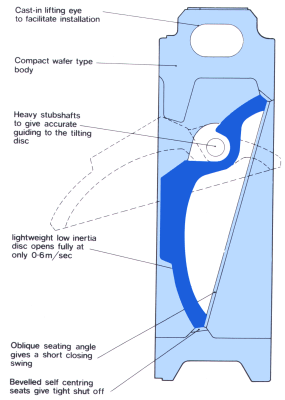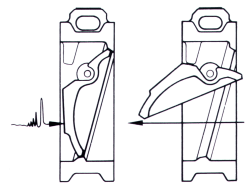Design features
Consider the following design features which have made Tilting Disc Check Valve the first choice among discerning engineers.
BODY – The circular wafer type body of the tilting disc check valve is designed to be clamped between adjacent pipe flanges and matches most international standards within the respective pressure ratings, e.g. ANSI 150/300 or PN 25/40/100. The wafer body is compact, lightweight and economical especially where expensive raw materials are concerned. Small face-to-face dimensions enable tilting disc check valves to be fitted into the most cramped of piping layouts.
An integrally cast-in lifting eye and flow direction arrow facilitate handling and installation and minimises down time if valves have to be removed from the pipeline.

DISC – Of lightweight, low inertia shape, designed for maximum strength and rigidity. Semi-balanced by the positioning of the stub shafts, it is able to open at low pressure differentials. Tilting disc check valves open fully at water velocities as low as 0.6m/sec, thereby overcoming “disc flutter” commonly found in conventional tilting disc check valves and which leads to rapid wear of the shaft and bearings and the inevitable falling-off in efficiency.
The disc is self-centring and sealing is effected by accurately turned and bevelled seats in the body and on the disc edge, giving tight shut-off at both high and low pressure differentials.
The oblique seating angle, 15° on valves to 450mm diameter (10° for valves 500mm and above) gives a short angle of swing from fully open to close.
STUB SHAFTS – A small but important element in the design of the tilting disc check valve, which so often is the cause of failure in conventional valves. These heavy stub shafts are positioned to give maximum strength with minimal clearance between the body and disc so that there is no unsupported length of shaft. All loads on the shaft are therefore carried in shear and not in a combination of bending and shear which can be the cause of so many failures in conventional valves used on steam and gas lines which are subject to rapid opening due to high velocity.
The stub shafts have seal welded covers on the outside of the body to eliminate all possible leakage to atmosphere, making the tilting disc check valve an ideal valve for hazardous or “fire safe” installations.
Why should a check valve close quickly?
The answer is, of course, to eliminate reverse flow but before a check valve can close all forward flow must have ceased completely. A quick reversing flow, as found in pump systems where one or more pumps feed into a high pressure main, requires that the check valve be very fast acting indeed if a large reverse flow is to be avoided. This loss is in itself a disadvantage but the resultant “water hammer” caused when the check valve does close has a far more serious implication. Under extreme conditions whole pipe and pump systems can be wrecked and even under less arduous conditions the cumulative effect of the shock waves can impair the proper working of the system and lead to an early breakdown with the subsequent high maintenance costs that this implies.

A usual method to reduce “water hammer” caused “by slow closing” check valves is to install dashpots to slow down the movement of the disc immediately before the seat is reached. The consequent high return flow must be accepted and the arrangement will be complicated and relatively expensive. It can also subject the disc and shaft assembly to excessive stresses when eventually the disc does close-off against the higher velocity return flow.
A better way is to make the natural frequency of the swinging clack or flap as high as possible so that the check valve closes quickly. Rapid-action means that no large reverse flow has time to build up before the valve closes. This is a radical solution to the problem of hammering.
The ideal check valve closes when the flow falls to zero but there is no check valve that does this when the flow reverses quickly. A certain reverse flow always occurs which causes hammering when the valve closes. In tilting disc check valves the disc is pivoted so that it swings as fast as possible – and the reverse flow is thereby minimised.
Principle
A small angle of travel between fully open and close, a short distance between the axis of the shaft and centre of gravity of the disc and an oblique seating angle.
We draw the analogy between a pendulum clock and a check valve to explain this principle.

Auxillary Spring
The basic principles of tilting disc check valve design ensure the fastest natural closing speed so that the valve is uncomplicated and reliable and may be truly termed a free acting check valve. However, we recognise that there are services where rapid turning liquids will generate “water hammer” conditions even in a valve as quick closing as a tilting disc check. To reduce this pressure surge to more acceptable limits, tilting disc check valves are designed to be fitted with auxiliary springs to accelerate the speed of closing. These springs are easy to fit or remove and may be mounted to unsprung valves already in service if operating conditions warrant it. With tilting disc check valves, remember that auxiliary springs are just that, unlike other valves which rely solely on the spring for their basic action.
Even an unlikely event of a broken spring does not destroy the proper function of tilting disc check valves.

Installation & Maintenance
General
The tilting disc check valve is designed for installation between two pipe flanges in horizontal pipelines with upward flow.
Installation
To obtain optimum function of the tilting disc check valve and of the circuit in which it is installed, the following instructions should be carefully followed. Consult if in doubt as to the location or function of the tilting disc check valve.
Clamp the valve between the two pipe flanges using through-bolts. Tilting disc check valves are available for all common international flange standards: see catalogue sheet below.
A flow-direction arrow is cast into the check valve body-lifting eye. Make certain that the medium’s flow coincides with this arrow.
Centre the tilting disc check valve carefully between the pipe flanges so that the disc can move freely (Fig 1) and is not obstructed by the edge of the pipe flange during operation (Fig 2).
Flange Gaskets
The valve has plane gasket faces. We recommend the following gasket widths for pressure class PN 25 (ANSI 150).
DN
40-150
200-300
350-500
600-1200
Gasket width mm
1.0
1.5
1.8
2.5
PN40/100 (ANSI 300) valve’s sealing surfaces are dimensioned for standard gaskets.
Centering
Insert the two bottom through-bolts in the pipe flanges and cradle the tilting disc check valve on these two bolts. Use correctly dimensioned shims to centre the valve. The centring operation may be aided by easing the valve into place with help of wedges hammered between the valve body and the through-bolts.
Make certain that the disc’s stub shafts are perfectly horizontal in the horizontal lines. The tilting disc check valve is correctly positioned when the lifting eye on top of the valve body is vertical.
Valves installed in vertical lines must, of course, also be accurately centred. In all conventional applications, the tilting disc check valve must open upwards.
Maintenance
Tilting disc check valves will normally not require any service work. The valve is available with an auxiliary spring to accelerate closing, or without a spring assembly. The springed version is recommended for fluid media. A springless version may easily be equipped with a spring to obtain extra rapid closing.
Valve Flange Index
PN 25-40-100 Class
Working Pressures & Temperatures
Face-to-face length
The tilting disc check valve is manufactured in DIN, VIS and BS standard versions with face-to-face lengths in accordance with SS-ISO 5752, as detailed in the table and drawing above. The face-to-face lengths in the ANSI and API versions correspond to ANSI dimensions as given on the ANSI 150-300 page.
Connection
As standard, the Tilting Disc Check Valve is intended for clamping between PN 10, 16, 25, 40, 64 and 100 pipe flanges in accordance with DIN, VIS, BS, ANSI and API standards.
Test Pressures
|
Pressure |
Test pressure*, bar Positive pressure – water |
|
|
PN 100 |
Open valve 150 |
Closed valve 110 |
|
* Leakage does not exceed 1 cm3/minute, irrespective of size, |
||
Material Specifications
ANSI 150-300
Test pressures
|
Pressure |
Test pressure*, psi |
|||
|
ANSI |
Open Valve |
Closed Valve |
||
|
150 300 |
Carbon 425 1100 |
Stainless 425 1075 |
Carbon 285 740 |
Stainless 275 720 |
|
* Leakage does not exceed 0.061 cu.in/minute, irrespective of size, |
||||
Material Specifications
Test pressures
|
Pressure |
Test pressure*, psi |
|||
|
ANSI |
Open Valve |
Closed Valve |
||
|
150 300 |
Carbon 425 1100 |
Stainless 425 1075 |
Carbon 285 740 |
Stainless 275 720 |
|
* Leakage does not exceed 0.061 cu.in/minute, irrespective of size, |
||||
Material Specifications
Certification
API 594:
Material & Physical Test Certification to DIN 50049.3.1.B can be supplied at extra cost and must be specified at time of order.
PN 25-40-100:
Material & Physical Test Certification to DIN 50049.2.2. DIN 50049.3.1B can be supplied at extra cost and must be specified at time of order.
Sizing & Pressure Drop
Valve Sizing
The chart below allows you to size a tilting disc check valve to give a specific pressure drop against a given flow rate of water. However, for air, steam, gases or other liquids you should consult our Sales Office for the sizing of Tilting Disc Check Valves.
Northvale Korting has invested in computer-aided design facilities and, to this extent, we can size valves for your applications and give accurate predictions of pressure drops etc. As such we require the following information:
|
Preferred units shown
|
|||
| FLUID |
LIQUID
|
GAS
|
STEAM
|
| NAME | |||
| FLOWRATE |
m3/hr
|
kg/hr
|
kg/hr
|
| INLET PRESSURE |
bar g
|
bar g
|
bar g
|
| PRESSURE DROP MAX. |
bar
|
bar
|
bar
|
| TEMPERATURE |
°C
|
°C
|
°C
|
| SG |
water=1
|
air=1
|
–
|
| VALVE ORIENTATION | |||
| LINE SIZE |
mm
|
mm
|
mm
|
Oversize Tilting Disc Check Valves
Oversized tilting disc check valves should not be used as this causes the disc to flutter and will quickly wear out the spindle bearings.
The lines a to d on the graph below represent the point at which the check valve attains its fully open position and therefore its correct sizing for its relative installation orientation.
a. Horizontal line with spring
b. Vertical line with spring
c. Horizontal line without spring
d. Vertical line without spring
Leakage Rate
The Tilting Disc Check Valve, when supplied, has an intended maximum leakage rate through the body/disc seating area of 1cm3per minute irrespective of valve size. This meets the requirements laid down for this test under API 598 and ANSI B16.34/MSS SP-61.
| Conversions | ||
| 1 m water guage approximately equal to | 3.28 | feet water guage |
| 1.42 | psi | |
| 0.098 | bar | |
| 1 m3/hr water approximately equal to | 0.28 | litres/sec |
| 3.66 | igpm | |
| 0.59 | ft3/min |
Contact us with any enquiries and we will be happy to help.










